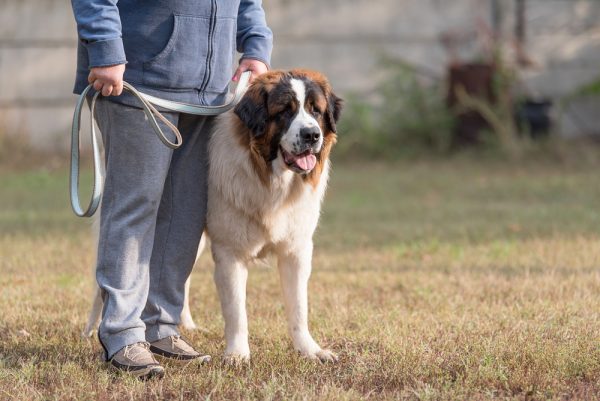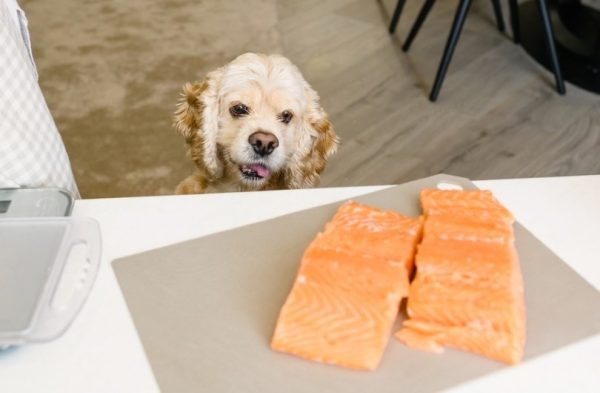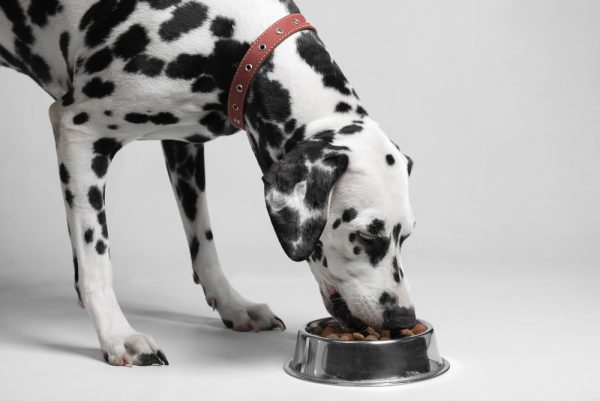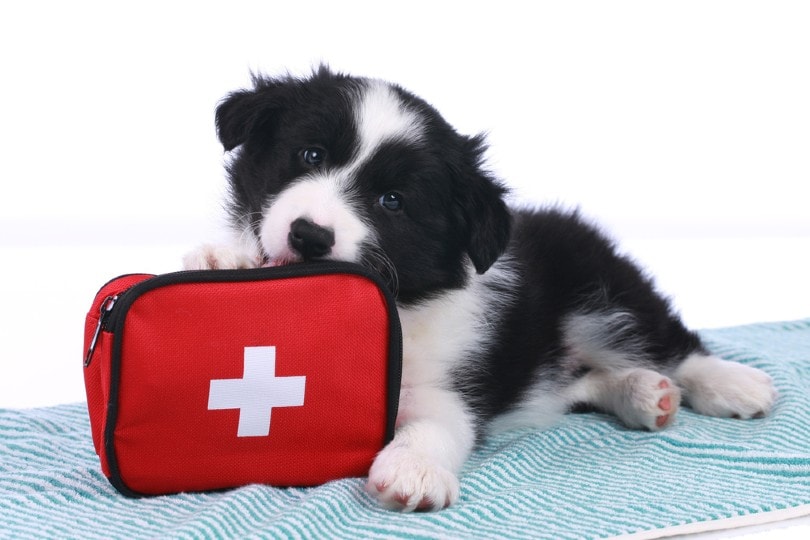
Hiking with your dog is a great bonding activity, but you need to be prepared before hitting the trails. Accidents and injuries can happen in the blink of an eye, so bringing a first aid kit along with you is a must. When you have the right supplies on you, you can not only tend to your pup’s injuries but even save his life.
You can make your own doggy first aid kit, but it’s simpler to buy one that is premade. They come in handy carrying cases most of the time, but some come with first aid manuals to guide you through basic dog first aid procedures. Plus, they come already stocked with all (or almost all) the supplies you need in case of an emergency.
Keep reading to find our reviews of the 9 best dog first aid kits on the market this year.
In this article

A Glance at Our Top Picks for 2025
| Rating | Image | Product | Details | |
|---|---|---|---|---|
| Best Overall |

|
Adventure Medical Kits Trail Dog Kit |
|
Check Price |
| Best Value |
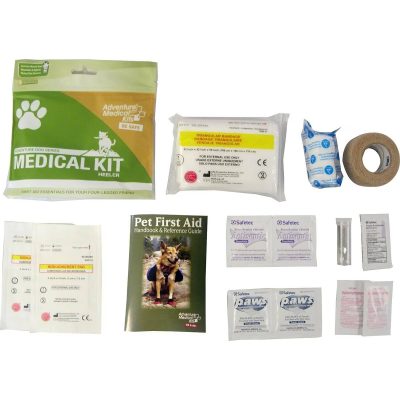
|
Adventure Medical Kits Heeler Dog Kit |
|
Check Price |
| Premium Choice |

|
Pet Evac Pak Big Dog Pak Emergency Kit |
|
Check Price |

|
Kurgo First Aid Kit for Dogs & Cats |
|
Check Price | |

|
Kurgo RSG First Aid Kit for Dogs |
|
Check Price |
The 9 Best Dog First Aid Kits
1. Adventure Medical Kits Trail Dog Kit – Best Overall

| Pieces: | 24 |
| Kit Dimensions: | 7.5 x 1.5 x 5.3 |
The Adventure Medical Kits Adventure Dog Series Trail Dog First Aid Kit for Dogs is the best overall first aid kit, offering a high-quality option for all dogs, including those that accompany their owners on hiking trails. This 24-piece kit is specifically designed for treating injuries your dog might endure on trails. It comes with supplies such as a splinter picker, irrigation syringe, antibiotic ointment, antiseptic wipes, and dressings and bandages.
The triangular bandage can double as a muzzle so you can administer first aid to your dog that might be scared or hurt. The last thing you need in an emergency is an injury to yourself that prevents you from providing care to your dog.
- Great price point
- First aid pamphlet included
- Bag is compact and lightweight
- Convenient carrying handle
- Dog-specific so not applicable to other pets
2. Adventure Medical Kits Heeler Dog Kit – Best Value

| Pieces: | 14 |
| Kit Dimensions: | 6.75 x 1.5 x 6.5 |
The best dog first aid kit for the money is the Adventure Medical Kits First Aid Kit for Dogs. This product contains all the essential supplies you and your canine pal could possibly need when you’re playing in your backyard or hiking.
This kit is small and compact, so it won’t weigh you down or be too cumbersome to tote around on your adventures. It has the basics you’ll need in an emergency, such as sterile dressings, muzzle, gauze bandages, tick remover, an antihistamine, and a first aid manual. We loved that this kit includes a muzzle so you can safely administer first aid to your scared and hurting dog in the event he becomes injured on your hike.
- Great for everyday use
- Kit is waterproof
- Small size to carry comfortably
- Great value for the price
- Comes in a plastic bag
- Not very durable
3. Pet Evac Pak Big Dog Pak Emergency Kit – Premium Choice

| Pieces: | 47 |
| Kit Dimensions: | 19H x 13.5W x 6.5D |
If you’re looking for the top-notch first aid kit for your 30-to-70-pound dog, the Pet Evac Pak Big Dog Pak Emergency Kit is it. This kit has everything you’ll need to keep your pup safe for up to 72 hours, making it a great pick for people who live in natural disaster-prone areas, too. The kit comes in a backpack style, making it simple to grab and go when disaster is afoot.
The backpack contains items such as emergency food and water packs, collapsible bowls, a mylar blanket, a rope toy, blood-stopping powder, a tweezer, and wound pads. It also comes with a waterproof ID holder to house any important medical documentation and a slip lead so you can escape quickly in the face of disaster.
- Perfect for disaster-prone areas
- Food and water have a five-year shelf life
- Lots of storage in the main compartment
- Includes basic first aid information
- Heavy
4. Kurgo First Aid Kit for Dogs & Cats

| Pieces: | 50 |
| Kit Dimensions: | 8.9 x 22.9 x 12.7 centimeters |
Another good dog first aid kit is Kurgo’s First Aid Kit for Dogs & Cats. This kit 50-piece set folds up to glove box size so you can store it in your vehicle or backpack for emergencies and injuries on the road. It features three interior mesh compartments as well as one zipper pocket on the outside to keep all of your first-aid essentials organized nicely.
This kit features supplies such as a thermal foil blanket, cold packs, bandages, trauma pads, gauze rolls and pads, and a handy first aid guidebook, so you know what to do in the case of an emergency.
- Can be used on other pets and humans
- A helpful first aid guide included
- Can put extra supplies inside if necessary
- Perfect size for travel
- Tweezers are low-quality
5. Kurgo RSG First Aid Kit for Dogs

| Pieces: | 49 |
| Kit Dimensions: | 8.5 x 6 x 4.25 |
The 49-piece Kurgo RSG First Aid Kit for Dogs provides enough supplies to provide first aid in minor accidents to emergencies. It contains supplies such as sting relief pads, tongue depressors, cleansing wipes, a cold pack, prep and trauma pads, and an emergency blanket.
This kit is inspired by military tactical gear and is MOLLE-compatible (Modular Lightweight Load-Carrying Equipment) and can easily be customized with MOLLE clips and patches.
Kurgo includes a first aid guide in this kit so you can provide the best care for your dog if he becomes injured.
- Dog can carry the kit on a utility vest
- Compact size
- Great for travel or home use
- Can fit additional supplies if necessary
- Carabiner can be difficult to release
6. Adventure Medical Kits Me & My Dog Kit

| Pieces: | 66 |
| Kit Dimensions: | 7.5″ x 3.5″ x 5.3″ |
Adventure Medical Kits brings us yet another fantastic first aid kit. The Adventure Medical Kits Dog Series Me & My Dog First Aid Kit for Dogs is similar in size and supplies to the other kits from the same company on our list, except that it has additional supplies specifically included for use on humans.
This kit is chock full of over 60 different supplies that both you and your pup can use in case you’re injured during your adventures together. There’s no need to weigh yourself down with a second human-specific first aid kit anymore.
This pack includes supplies such as Aspirin, an antihistamine, bandages, gloves, antiseptic wipes, bandages, a cold compress, and an emergency blanket.
- Comprehensive kit
- Eliminates the need for two first aid kits
- Easy to pack
- Room to add additional supplies
- Includes first aid booklet
- No quick stop product for bleeding
7. ARCA PET Cat & Dog First Aid Kit

| Pieces: | 87 |
| Kit Dimensions: | 8.5 x 6.5 x 3.25 inches |
The comprehensive ARCA Pet Cat & Dog First Aid Kit provides over 80 contents and provides peace of mind that you’ll be ready in case an injury or emergency happens.
The kit itself features a night-reflective zipper and glow-in-the-dark lettering so it’s simple to find no matter the time of day. It is lightweight in design and can be used in a wide variety of settings, including at home, while camping, or on road trips.
The kit includes supplies such as a digital thermometer, pet eyewash, antibiotic ointment, emergency slip lead, sting relief pads, and soap wipes.
- Kit folds open so finding supplies is easy
- Includes tourniquets to stop bleeding
- Compact design
- Room to add more items
- Manual is not thorough
8. Labra Pet First Aid Kit for Dogs

| Pieces: | 28 |
| Kit Dimensions: | 18.1 x 15.2 x 5.1 centimeters |
The Labra Pet First Aid Kit for Dogs is compact but surprisingly well-stocked and should have the essentials you need to disinfect and stabilize minor injuries. It’s very lightweight and portable so carrying it with you on walks or hikes isn’t cumbersome.
The kit includes supplies to treat cuts, sprains, and scrapes. Some of the contents include scissors, bandages, antiseptic wipes, a pet brush, and cotton swabs.
- Very compact size
- Reasonable price tag
- Lightweight
- Scissors and tweezers are fragile
- Doesn’t come with a list of contents or what they’re used for
9. Go2Kits Pet First Aid Kit Basics for Dogs & Cats
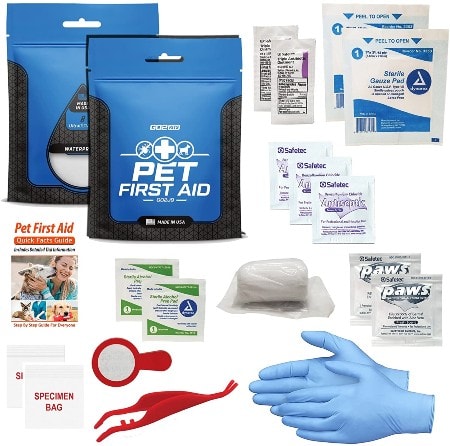
| Pieces: | 20 |
| Kit Dimensions: | 5 x 4 x 2 inches |
The compact, 20-piece Go2Kits Pet First Aid Kit Basics Plus Tick Remover Tool for Dogs & Cats is well-organized and waterproof to keep the contents safe in adverse weather. The size is very small, which allows it to store conveniently in your glove box or backpack.
The kit comes with a helpful first aid guide that walks you through basic pet first aid and also provides instructions on how to remove a tick safely. You can even keep the tick in the included specimen bag to bring to your vet for testing purposes. Taking the tick for testing can tell you if it had any dangerous infections like Lyme disease that you’ll need to keep an eye out for.
- Waterproof
- Great for outdoor adventures
- Made in the USA
- Well packaged
- Missing some key supplies
- Bag is not as durable as cloth or canvas bags

Buyer’s Guide: How to Choose the Best Dog First Aid Kit
Buying a first aid kit for your dog can be overwhelming. There are so many different kits on the market, all with different supplies. How do you know what kit will be the best for your needs? What supplies are the most important to have? Here are some factors to consider as you begin shopping.
Supplies
The most important part of a dog first aid kit is the supplies inside. A poorly stocked kit or one with low-quality supplies isn’t going to be helpful if your dog gets injured. You want to invest in a kit that has all the supplies you might need in an emergency but the supplies need to be of quality, too. Adhesive tape that’s old and no longer sticky or tweezers that break on their first use aren’t going to be very helpful.
Bigger doesn’t always mean better when it comes to first aid kits, either. You might be tempted to go for a bag with hundreds of items but just because there are a lot of supplies doesn’t mean that the kit is superior. A kit with 200 items might sound good on paper but many of those items might prove to be unnecessary or unusable anyway.
Make sure you’re reading the full supply list of the kit you’re looking to buy.
- Antibiotic ointment or spray
- Alcohol wipes
- Gauze
- Scissors
- Gloves
- Blanket
- Non-stick bandages
- Adhesive tape
- Peroxide
- Tweezers
- First aid guide
Don’t fret if your favorite first aid kit doesn’t contain some of the supplies above. You can purchase them separately and add them to the bag, provided there’s room for additional supplies.
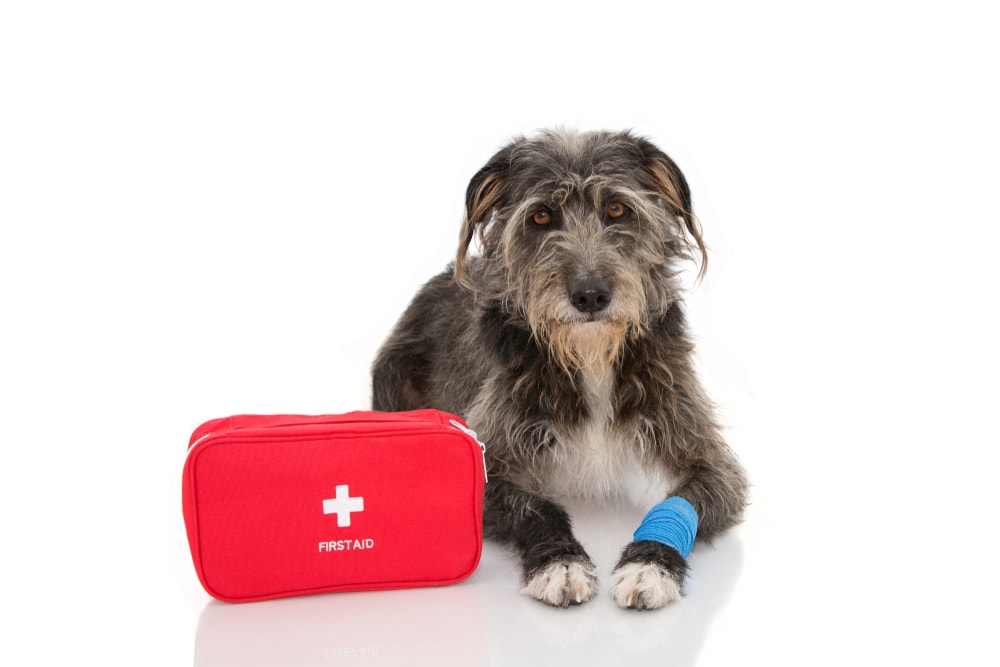
Size
Size is important if you plan on going places with your first aid kit so before you buy yours, think about where you’ll be using it.
If you and your pup enjoy a frequent hike or camping trip, you don’t want to select a kit that’s in backpack form if you also plan on carrying your own hiking backpack. You also don’t want a bulky and heavy first aid kit if you’re a hiker as it will tire you out faster.
If you’re looking for something to keep at home for emergencies, size isn’t as much of a concern, provided you have somewhere to store a bigger kit.
If you want a kit for your car, you might want something a bit more compact that’ll fit in your glove compartment.
Design
While the design of the first aid kit is arguably less essential than the supplies inside, it’s still worth considering. The best kits will have some organizational component—be it mesh pockets or zippered areas for the supplies. Pockets and zippers will keep your supplies where they’re supposed to be in the kit and make them easier to find in the event of an emergency or injury.
Other than organizing it properly, your kit’s design should be sturdy and durable. You don’t want a bag that’s going to tear and scatter your first aid supplies everywhere. A waterproof design is also beneficial as it will keep the contents dry if you’re hiking and encounter a rainstorm.
How We Selected These Dog First Aid Kits
This buyer’s guide was carefully crafted by our writers and editors in collaboration with our team of in-house veterinarians. The dog first aid kits reviewed here are rated on a combination of factors: brand reputation, customer reviews across multiple retail outlets, personal experience, and in some cases, feedback from our own dogs! Together, we choose and review only the best dog first aid kits available, to help you make the most informed decisions that foster the well-being of your furry friends.
Why Trust Dogster?
Dogster has been a trusted brand for dog owners online since 2004, which means we have a lot of experience with dog first aid kits. We are a team of passionate dog owners who care about our pups as much as you do yours. We want the best for every canine on the planet. Dogster’s writers, editors, and veterinarians are deeply invested in the well-being of our pets, and we believe that all pet owners share this dedication to providing only the highest quality products and services for our dogs.

Conclusion
For the best overall dog first aid kit, Adventure Medical Kits Adventure Dog Series Trail Dog First Aid Kit for Dogs provides the most inclusive kit in a durable bag. Dog owners on a budget can appreciate Adventure Medical Kits’ Heeler Dog Kit with its comprehensive supply list and affordable price tag. For those for whom money is no object, Pet Evac Pak’s Big Dog Pak Emergency Kit is the clear winner as it is effective for providing disaster relief as well as first aid.
We hope our reviews above make choosing a kit easier. In the end, all that matters is that you have the supplies you need to keep your dog safe if he becomes injured.
Featured Image Credit: absolutimages, Shutterstock











